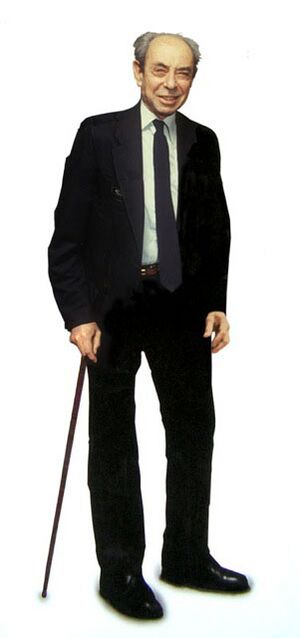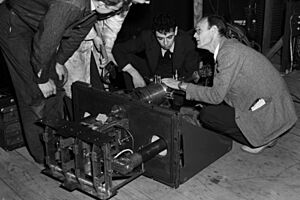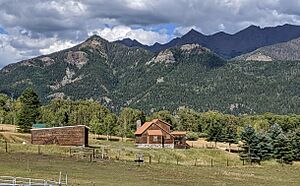Frank Oppenheimer facts for kids
Quick facts for kids
Frank Oppenheimer
|
|
|---|---|
 |
|
| Born |
Frank Friedman Oppenheimer
August 14, 1912 New York City, U.S.
|
| Died | February 3, 1985 (aged 72) Sausalito, California, U.S.
|
| Education | |
| Known for |
|
| Spouse(s) |
|
| Children | 3 |
| Relatives | J. Robert Oppenheimer (brother) |
| Awards |
|
| Scientific career | |
| Fields |
|
| Institutions | |
| Thesis | Beta Ray Spectra (1939) |
Frank Friedman Oppenheimer (born August 14, 1912 – died February 3, 1985) was an American scientist. He was a particle physicist, a cattle rancher, and a physics professor. He is best known as the founder of the Exploratorium in San Francisco.
Frank was the younger brother of the famous physicist J. Robert Oppenheimer. Frank worked on nuclear physics during World War II. He helped with the Manhattan Project, which developed the first atomic weapons. After the war, Frank faced problems because he had been part of the American Communist Party earlier. He lost his job at the University of Minnesota.
During a time called McCarthyism, he was not allowed to teach physics. This lasted until 1957, when he could teach science at a high school. Later, he became a physics professor at the University of Colorado. In 1969, Frank Oppenheimer started the Exploratorium. This was a new kind of science museum in San Francisco. He led the museum until he passed away in 1985.
Contents
Early Life and Learning
Frank Friedman Oppenheimer was born in 1912 in New York City. His family was Jewish. His mother, Ella, was a painter. His father, Julius, was a successful textile importer. As a child, Frank enjoyed painting. He also learned to play the flute very well. He even thought about becoming a professional flutist.
Frank was always very close to his older brother, Robert. Robert was also a brilliant scientist.
Frank went to the Ethical Culture School for his early education. He later finished high school at the Fieldston School.
Following his brother Robert's advice, Frank decided to become a physicist. In 1930, he started studying at Johns Hopkins University. He earned his physics degree three years later. He then spent 18 months studying in England. While there, he also learned to fly a plane. In 1935, he worked in Italy. He helped develop counters for tiny nuclear particles.
While getting his PhD at the California Institute of Technology, Frank met Jacquenette Quann. She was an economics student and active in the Young Communist League. Frank and Jackie got married in 1936. They both joined the American Communist Party. This was against his brother Robert's advice. Frank and Jackie were also atheists.
Frank earned his PhD in 1939. He then did two more years of research at Stanford University.
A Career in Physics
During World War II, Frank's brother Robert led the Los Alamos Laboratory. This lab was part of the Manhattan Project. The project aimed to build the first atomic weapons. From 1941 to 1945, Frank worked at the Lawrence Berkeley National Laboratory. He focused on separating uranium isotopes. This work was important for making atomic bombs.
In late 1943, he moved to the Los Alamos Laboratory. He helped with the tools for the Trinity test site in New Mexico. This was where the first atomic bomb was tested. In 1945, he went to Oak Ridge, Tennessee. He helped check the equipment there.
After the war, Frank helped start the Association of Los Alamos Scientists. This group wanted to control nuclear power peacefully. He also joined other science organizations.
Frank then returned to Berkeley. He worked on developing a proton linear accelerator. In 1947, he became a physics professor at the University of Minnesota. There, he helped discover heavy cosmic ray nuclei.
Facing Political Challenges
In 1947, a newspaper reported that Frank Oppenheimer had been a Communist Party member. At first, he denied it, but later said it was true. In 1949, he was called before the House Un-American Activities Committee (HUAC). This was a government group that investigated suspected Communists.
Frank told the committee that he and his wife had been party members for about three and a half years. He explained they joined during the Great Depression. They were looking for answers to the high unemployment. He refused to name other members he knew. This caused a big stir in the news. It led to Frank resigning from his job at the University of Minnesota.
After being labeled a Communist, Frank could not find physics work in the U.S. He was also not allowed to get a passport. This meant he could not work abroad. He and his wife sold a painting they owned. With the money, they bought a 1,500-acre ranch in Colorado. They spent almost ten years as cattle ranchers.
Back to Teaching Science
By 1957, the Red Scare had calmed down. Frank Oppenheimer was then allowed to teach science at a local high school.
Frank taught many science subjects. These included chemistry, physics, and biology. He taught at the high school in Pagosa Springs, Colorado. He said he wanted to share his love for science with young people. He wanted to prepare them for higher education in science.
With Frank's help, several students from Pagosa Springs High School won first prize at the Colorado State Science Fair. After two years, other famous physicists supported him. Frank was then offered a physics teaching job at the University of Colorado.
While doing particle physics research again, Frank became very interested in improving science education. He received money to create new teaching methods. This led to a "Library of Experiments." It was a collection of nearly one hundred science models. These models could help teach physics to younger students. These models later became the first exhibits at the Exploratorium. Frank also helped develop a new high school physics curriculum.
Frank believed in the old Latin saying, Docendo discimus. This means "the best way to learn is to teach."
The Exploratorium
In 1965, Frank Oppenheimer received a special grant. He used it to study the history of physics in London. There, he saw European science museums for the first time. He wanted to create a similar place in the United States. He was offered a job to plan a new part of the Smithsonian Institution. But he chose to create a new, independent museum in San Francisco.
Four years later, in 1969, the Exploratorium opened. It was located in the Palace of Fine Arts in San Francisco. Frank got money from the San Francisco Foundation to open the museum. The foundation gave him $50,000.
Oppenheimer was the museum's first director. He stayed involved in its daily work. He had visited the Tel Aviv Science Museum in 1965. He used some of their exhibit ideas for the Exploratorium. The first exhibits were built with help from other science labs.
Frank always believed that art and science were equally important. He asked artist Bob Miller to create "Sun Painting." This was the first big art piece at the Exploratorium. Another early exhibit was the "Tactile Dome" (1971). This was a dark, winding passage. Visitors had to use their sense of touch to explore it. Both of these exhibits are still at the museum today. In 1974, Frank started a program for artists to work at the Exploratorium. This brought together artists and scientists.
The Exploratorium offered "educational sightseeing." It helped people understand science principles. The exhibits were set up so visitors could explore freely. Instead of tour guides, the museum hired "explainers." These were college or high school students, and some adults. They showed how exhibits worked and explained the science. They walked around with visitors instead of leading tours.
Final Years
In 1977, Frank was diagnosed with lymphoma. He had two years of successful treatment. His first wife, Jacquenette, passed away in 1980. In 1982, he married Mildred "Milly" Danielson.
In 1983, doctors found lung cancer. Frank was a heavy smoker. He had surgery, but he kept playing his flute. He remained active, going to the Exploratorium almost every day. He passed away at home in Sausalito, California, on February 3, 1985.
His Legacy
When Frank Oppenheimer died in 1985, he left behind his second wife, Mildred. He also had a son, Michael, and a daughter, Judith. He had another daughter, Sarah, from a relationship with a friend's wife. Sarah was raised by her mother and the friend. She only learned about her connection to Frank in 2019. Sarah and Michael confirmed their genetic link in 2020.
Frank Oppenheimer's papers and records are kept at the Bancroft Library in California. This collection includes over 60 of his writings. Most of it covers his physics and education work before he founded the Exploratorium. It also has papers about his investigation by the House Un-American Activities Committee (HUAC). The Exploratorium's history records are also there.
Frank believed the Exploratorium and its education programs were his most important achievement. A collection of his papers on science, art, and education is available online.
The Frank Oppenheimer Fellowship Fund was created at the Exploratorium. It helps science museum staff exchange ideas and knowledge around the world.
Awards and Honors
- Distinguished Service Award, University of Colorado
- Distinguished Alumni Award, Caltech
- Guggenheim Fellowship (1965)
- Millikan Award, American Association of Physics Teachers (AAPT) (1973)
- Distinguished Service Award, American Association of Museums (AAM) (1982)
- Oersted Medal, American Association of Physics Teachers (AAPT) (1984)
- Kirkwood Award for Distinguished Service, Caltech
See also
- Hybrid arts
- Science education
- Science museums



